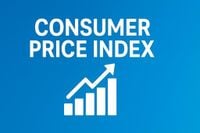For Americans keeping a close eye on their wallets, the latest inflation report delivered a mixed bag—prices are still climbing, but not as sharply as many had feared. According to the Bureau of Labor Statistics (BLS), year-over-year inflation reached 3.0% in September 2025, a slight uptick from August’s 2.9% but still shy of the 3.1% forecast by economists. This modest rise, though not exactly cause for celebration, at least offered a glimmer of relief for consumers and policymakers alike who have been bracing for worse.
The September Consumer Price Index (CPI) report, released on October 24 after a delay caused by the ongoing government shutdown, showed that prices for a broad basket of goods and services rose just 0.3% over the month. That’s below the 0.4% increase many had expected, and it mirrors the prior month’s more subdued pace. Core CPI—which strips out the more volatile food and energy prices—also came in at 0.2% for the month and 3.0% for the year, both under economists’ predictions. As CNBC noted, "Prices that people pay for a variety of goods and services rose less than expected in September, according to a Bureau of Labor Statistics report Friday that keeps the door wide open for another interest rate cut next week."
This softer-than-anticipated inflation reading comes at a time when Americans are hungry for economic clarity. The government shutdown that began October 1 has left most official data releases in limbo, making this CPI report the only major economic indicator available to the public and policymakers. As John Kerschner, global head of securitized products at Janus Henderson, colorfully put it to CNBC, "Like an oasis slaking the thirst of a weary desert traveler, today's CPI number offered investors the first tidbit of information from the barren wasteland of government data that has existed since the shutdown started Oct 1."
So, what’s driving these numbers? The BLS pointed to gasoline as the main culprit behind the monthly price rise—a 4.1% surge in gas prices in September, more than double the previous month’s 1.9% jump. Yet, in a twist, gasoline is actually cheaper than it was a year ago, down 0.5% annually. Food prices also crept up, with a 0.2% monthly increase and a 3.1% year-over-year rise. Within the food category, beef and veal prices stood out, soaring 14.7% over the year—the sharpest increase since March 2022. Meat, poultry, fish, and eggs collectively rose 5.2% year-over-year, while nonalcoholic beverages climbed 5.3%.
Shelter, a major component of the CPI, saw a 0.2% monthly increase and a 3.6% annual rise. New vehicle prices nudged up by 0.8% in September, but used cars and trucks actually became more affordable, with prices falling 0.4% for the month. Energy prices overall were up 2.8% year-over-year, with electricity and natural gas seeing notable increases of 5.1% and 11.7%, respectively.
For those relying on Social Security, the timing of the CPI release is crucial. The Social Security Administration uses these inflation figures to calculate the annual cost-of-living adjustment (COLA) for benefits. Without this data, millions of Americans would be left guessing about their future income. As CNBC explained, "The BLS released the data specifically because the Social Security Administration uses it as a benchmark for cost-of living adjustments in benefit checks."
Meanwhile, the Federal Reserve is gearing up for its next rate-setting meeting on October 28 and 29. With the CPI report in hand—and little else by way of fresh government data—Fed officials face a tricky balancing act. They’re expected to cut interest rates by 25 basis points, a move that many see as a response to the softer inflation and an uncertain labor market. According to Business Insider, "The Fed cut rates for the first time this year in September, providing some relief to Americans' wallets, and is expected to make another rate cut." The CME FedWatch tool shows that markets are almost certain the central bank will lower its benchmark overnight borrowing rate by a quarter percentage point from its current 4%-4.25% range.
The jobs picture, however, remains murky. The BLS’s usual employment reports have been delayed by the shutdown, forcing the Fed to rely on private data and older numbers to assess the labor market’s health. Some policymakers are increasingly focused on supporting jobs, especially as inflation risks seem more transitory and tariff-driven. As a note from Raymond James highlighted before the latest CPI report, "In our view, the Fed is increasingly focused on supporting the labor market, especially as inflation risks appear transitory and tariff-driven."
Tariffs, in fact, continue to be a wild card. While the CPI report showed only limited impact from President Donald Trump’s tariffs so far, there are lingering concerns that higher duties on imported goods could eventually stoke another round of inflation. Apparel prices sensitive to tariffs rose 0.7% in September, and durable goods were up 0.3%. Still, as James Knightley, chief international economist at ING, wrote, "There are signs of a strong substitution effect already coming through – US companies switching to lower tariff countries for their product sourcing with the composition of imports shifting. The result is companies are better able to absorb these more modest than feared cost increases and there has been less impact on inflation than predicted so far." Knightley added, "We continue to argue that tariffs will be a one-off step change in prices rather than something that will lead to more persistent inflation."
Market reactions were swift but measured. Stock futures ticked up, and bond yields dipped slightly after the CPI numbers came out. Investors seemed relieved that inflation wasn’t running hotter, but uncertainty still looms large. As Art Hogan, chief market strategist at B. Riley Wealth, told CNBC, "This report will clearly keep the Fed on track to cut rates. The Fed has been clear that they are more focused on the softening labor data and will continue to defend their full employment mandate, even with core CPI well above their 2% target."
Looking ahead, inflation expectations are ticking up. A New York Fed survey found that median inflation expectations for one year ahead rose from 3.2% in August to 3.4% in September, the third consecutive monthly increase. It’s a sign that while the current numbers are manageable, Americans aren’t convinced the pressure on their budgets will ease anytime soon.
With so much uncertainty—about tariffs, the labor market, and the government’s own ability to function—the September inflation report is a rare, if imperfect, window into the state of the U.S. economy. For now, the numbers suggest a delicate balance: inflation that’s stubborn but not spiraling, and a central bank ready to act, even as it flies partly blind. As the shutdown drags on and the Fed prepares for its next move, Americans can only hope for clearer skies—and clearer data—on the horizon.

